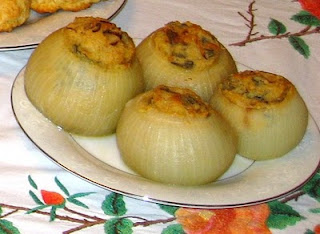
I love this
cold roasted vegetable salad. I mentioned this in a previous post, but just to say it again: I think this is
one of the best things to eat during the summer. You get all the concentrated flavor of the vegetables from roasting/grilling, but serving this chilled helps fight off the summer heat. The flavors are also a firework symphony. This is vibrant, bright, and fun. You have sweetness, earthiness, creaminess (avocado), mellow warmth, bright acidity (lime juice in the dressing), umami (also from the dressing)... Really, do I need to say more? This salad goes on the must-make list.
You'll need:
1 medium-sized eggplant,
1-2 ripe tomatoes,
2-3 bell peppers, and
1 ripe avocado. I like to use red, yellow, and orange bell peppers for the colors they add, but green would work just as well. If you like the flavor of garlic, you can also throw in
3 cloves of garlic.
- Slice the eggplant into medallions about a finger's-width in thickness. Brush the medallions with olive oil on both sides
- Slice the bell peppers into matchsticks. Toss with olive oil.
- Score the tomatoes on the bottom with an X.
- Toss the garlic cloves in a healthy dose of olive oil (optional).
- Arrange the eggplant, bell peppers, tomatoes, an garlic cloves onto a baking sheet. Bake at 350F for 30 minutes. Flip the eggplant medallions and toss the bell peppers around a bit and then turn off the oven leaving the vegetables inside for another 20 minutes.
Alternatively, you can grill the eggplant and bell peppers. You can also roast the tomatoes over the grill by scoring them on the bottom and wrapping them in aluminum foil.

After the vegetables have been roasted and cooled, peel the skin off of the tomatoes and garlic cloves (if using). Slice the eggplant into matchsticks like the bell pepper. Chop the garlic clove and the tomatoes. Dice up the avocado (without the skin, obviously). Combine all the vegetables into a large bowl/container.
Up till this point, this probably sounded like a very boring/normal recipe. But this part is the most important part:
the dressing.
I make a
salad dressing out of lime juice that is my go-to for all salads. It works wonders on romaine, spinach, etc.
Juice one lime (I can often get about 2-3 tablespoons). Add enough
sugar to cut the acid. I think I probably use 3 tablespoons, if not more, but taste it as you go. You don't want it to be sweet, but you also don't want to make the
oh so sour! face when you try it. Then I add 3-4 good dashes of
Maggi seasoning sauce, maybe a scant quarter teaspoon. This stuff is the magic ingredient. I know many people may not keep this in their kitchens, but honestly, it is amazing. I add this to omelets and fried rice. I use it to marinate chicken and ribs. When I was growing up, sometimes for dinner all I wanted was Maggi sauce on white rice. It is somewhat like soy sauce, except... bolder in taste. And it isn't actually made from soy. I really can't describe it any better. Just go buy it. You can probably find it in your local grocery store (it is a Nestle brand of seasoning).
Adjust the dressing to your taste. It should be a good balance of sweet, sour, salty, and umami. I probably use 4-5 tablespoons of this to dress the vegetable salad. Toss/stir and then allow the salad to chill in the fridge for at least an hour. Often, I wait 4-5 hours before serving. (In a plastic container with a lid, this will keep in the fridge for about 5 days, if it lasts that long.)
The end result is a roasted vegetable salad that is
cold, refreshing, and vibrant. The lime brings a bright flavor that compliments the earthy, warm flavors of the eggplant and bell peppers, while the roasted tomato has a soft acidity to it that works well with the avocado's creaminess. All of the flavors harmonize with the
umami, sweet, sour, and slightly salty dressing. This salad can be a meal in and of itself, but it also works great as a side to steak, grill chicken, ribs, pork chops, you name it.













































